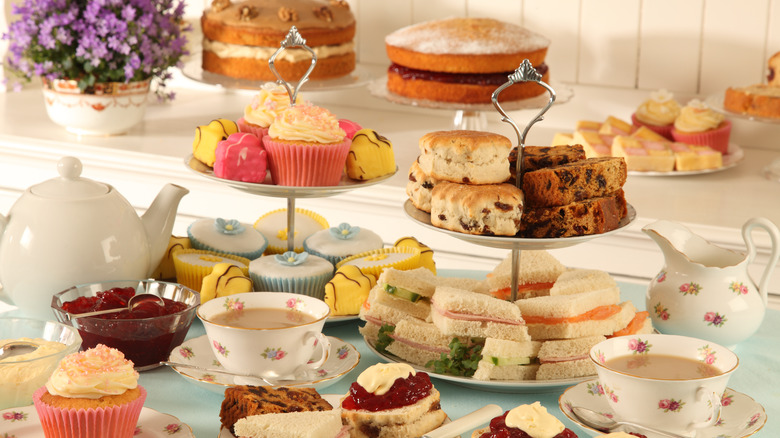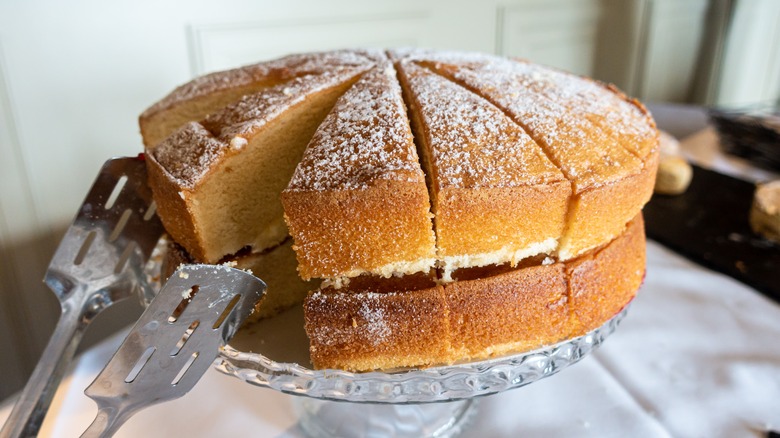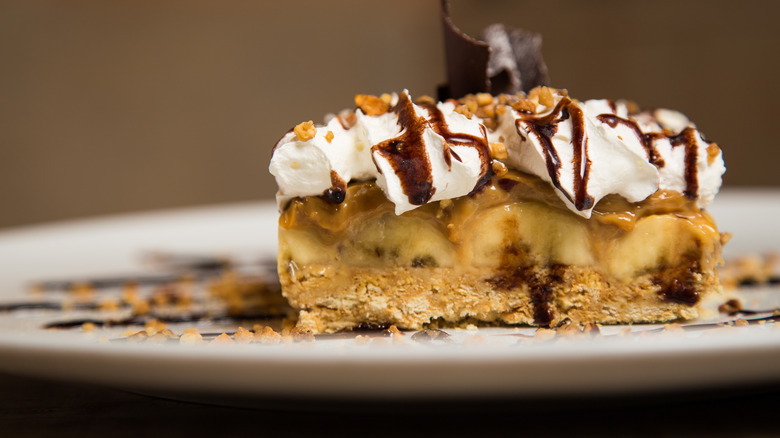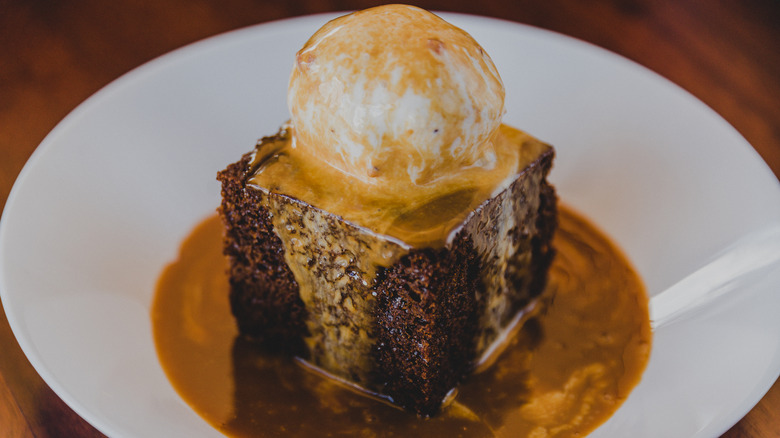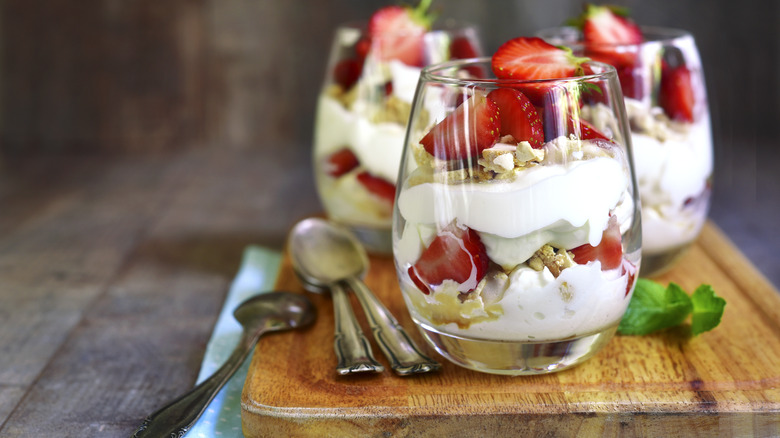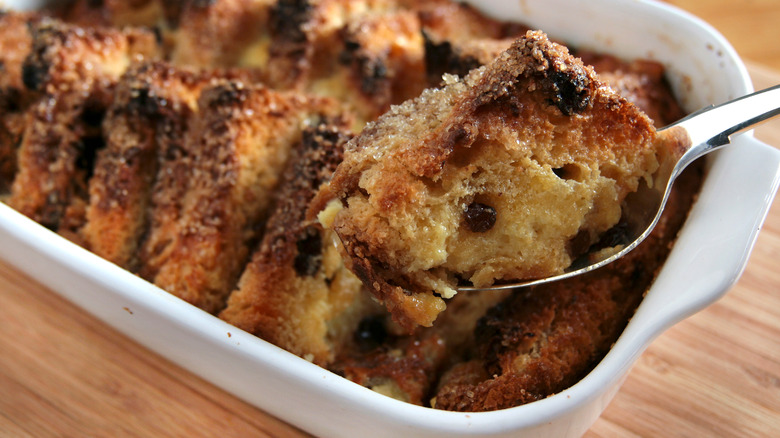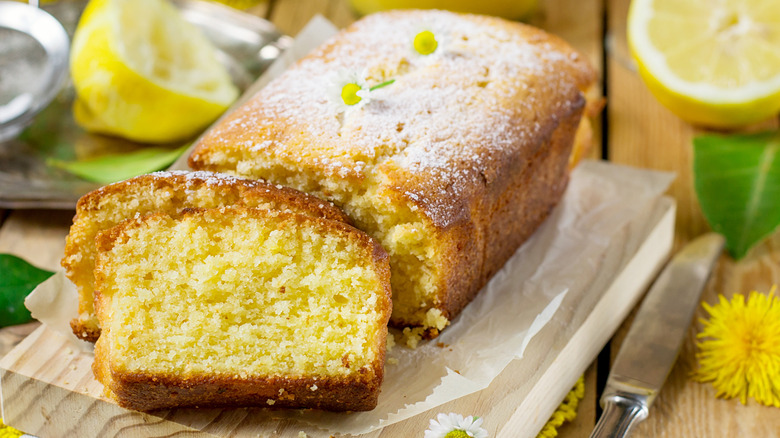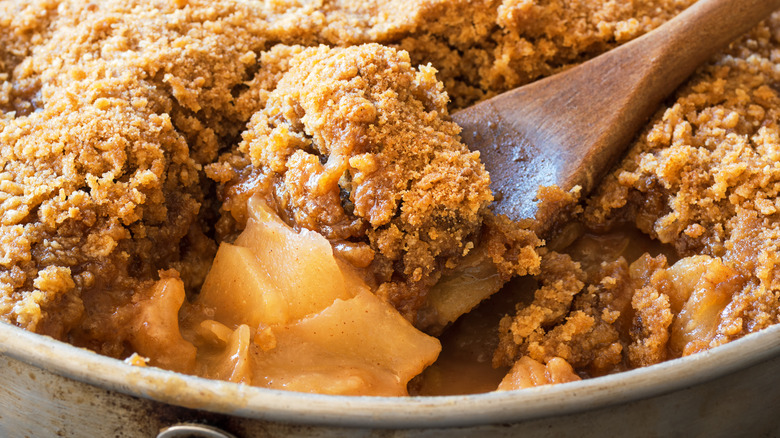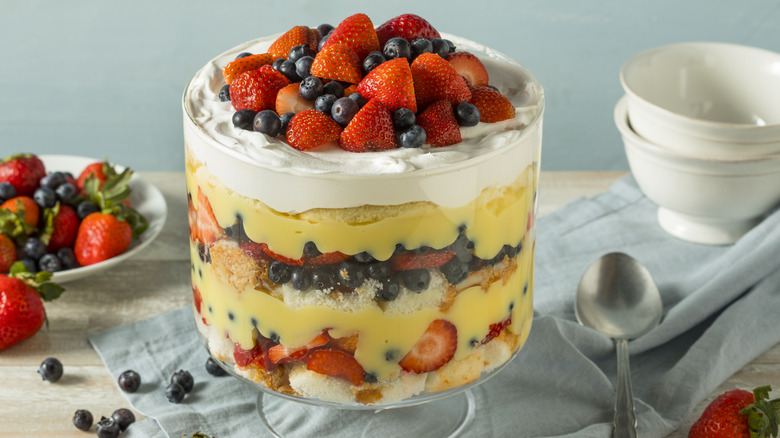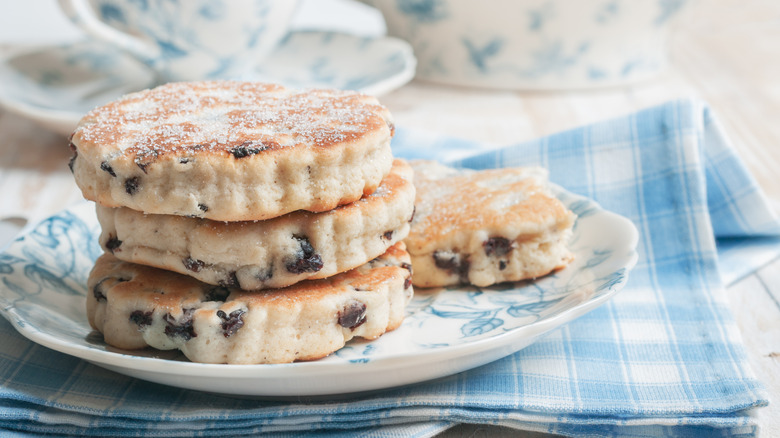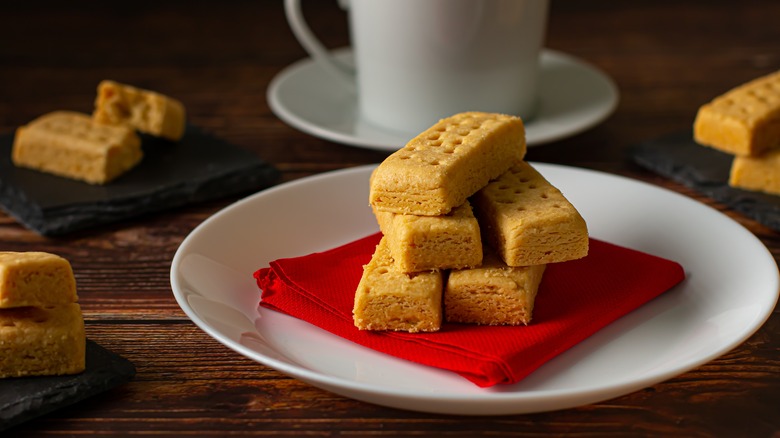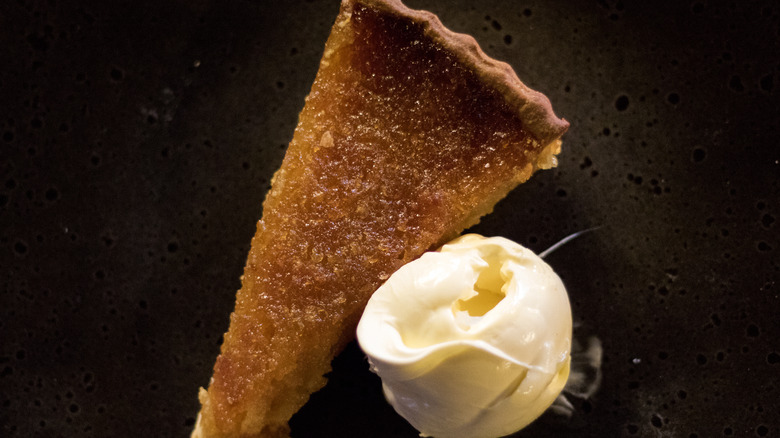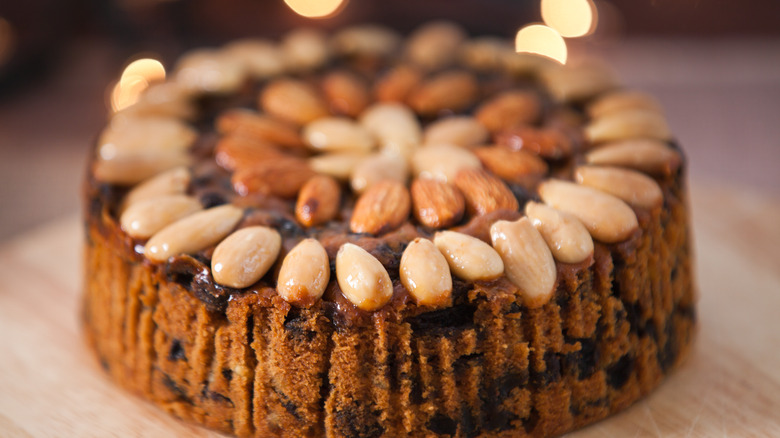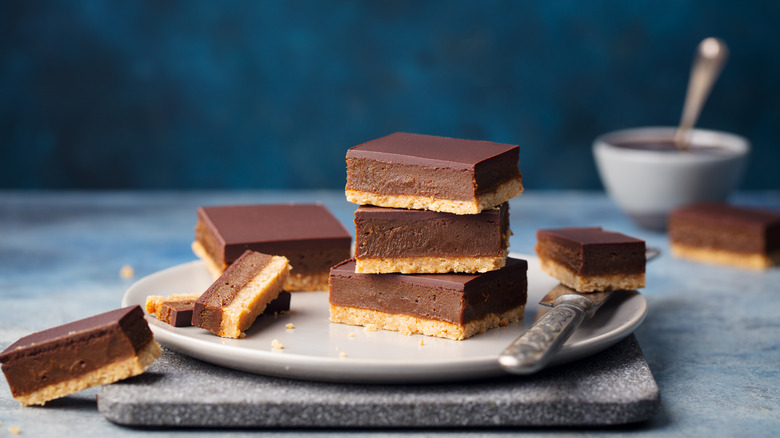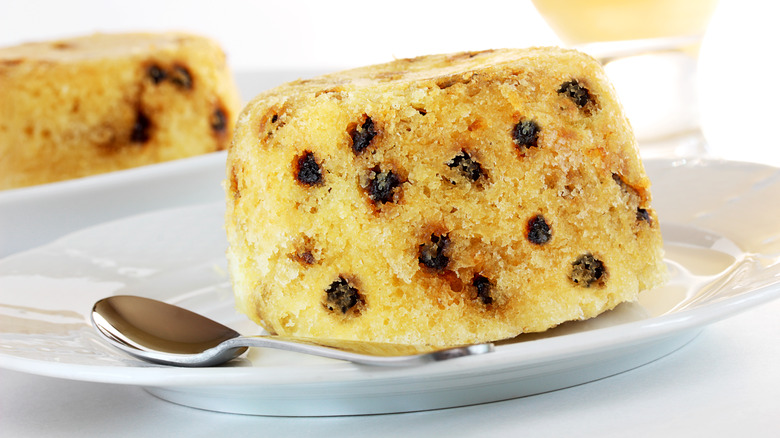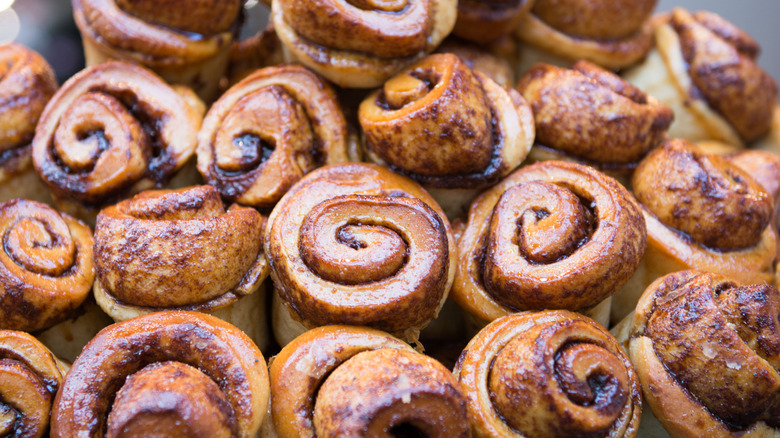15 British Baked Sweet Treats You'll Want To Try
Netflix (and PBS) sensation "The Great British Baking Off" has helped to highlight and celebrate some of Britain's most loved baked treats. Like in many other cultures, there are a few, often unspoken, but foundational aspects to British eating and drinking. This includes, but is not limited to, Sunday roasts, pub snacks, where and when to eat fish & chips (by the seaside!) and teatime treats to accompany a cuppa, which should be taken mid-morning (elevenses) or mid-afternoon.
Sweet baked treats are not just for dessert after a meal in the U.K.; they can also be made to accompany a cup of tea, though they will often be less sweet than the customary dessert offerings. Once only affordable to the elite classes and royalty, tea time in England is now an all-encompassing affair. It is both customary and delicious to serve a pot alongside a subtly sweetened, baked treat or cookie (biscuit). That said, a long blustery walk followed by a hearty pub meal and a rich dessert to finish will forever remain irreplaceable in the hearts of many Britons.
Whether savored morning, noon, or night, there are a number of sweet treats you can enjoy in the U.K. Here are some of the most beloved desserts (or puddings) you'll want to try.
Victoria sponge
Victoria sponge is one of the most classic and quintessential British desserts. It was created in the 19th century, at the request of Anne Russell, the Duchess of Bedford, as a means of warding off mid-afternoon hunger pangs in anticipation of the evening meal, which was then eaten between 8 p.m. and 9 p.m. (via Grants Bakery). Though the sponge had already existed for several centuries, it was this combination of jam, cream, and sponge that made its formal debut in front of many of Anne's friends, including Queen Victoria. This royal association cemented the cake's place within upper-class and elite circles, a reputation that still has some stronghold even today.
Queen Victoria was well known for her sweet tooth, as well as her trendsetting staying power within popular culture. According to Town & Country, she popularized the custom to wear a white wedding gown, alongside the commissioning of opulent wedding cakes to commemorate the occasion, as she did when marrying Prince Albert. Her cake, though not sponge, was recorded to have weighed around 300 pounds (via National Geographic)! Thankfully, a Victoria sponge recipe is quite manageable and easy to perfect.
Banoffee pie
Unlike a Victoria sponge, banoffee pie is relatively new on the scene in the British desserts world, but that doesn't mean you should discredit it. Quite the contrary. According to The Independent, we owe restaurateur Nigel Mackenzie a load of gratitude for giving the people what they didn't know they wanted when he created the banana and toffee portmanteau in 1972.
Mackenzie and his wife came about the decadent pie under pressure, in search of one more dessert to serve at their newly purchased restaurant, The Hungry Monk. While the name references toffee given the texture, really it's more of a caramel. Whatever you choose to call it, paired with slivers of banana, the combination is unbeatable. The dessert became a permanent addition to the menu, with a powerful ripple effect. When the recipe for banoffee pie was released in the pair's cookbook, "The Deeper Secrets of the Hungry Monk," there was no looking back; banoffee pie was here to stay.
Sticky toffee pudding
If we had to pick just one dessert to eat forevermore, this would be one of the top contenders. While sticky toffee pudding is undoubtedly a classic British food, Its origins, however, aren't as clear cut. Some believe sticky toffee pudding was originally introduced by the Sharrow Bay Hotel in Cumbria, England, in the early 1970s (via BBC Travel). Cumbria was once home to one of England's largest harbors, receiving smuggled shipments of dates and sugar — two of the dessert's most important ingredients— imported from plantations in the Caribbean as part of the spice trade. However, according to The Westmorland Gazette, both Lancashire and Canada have also made claims to having invented the now widely popular, hard-to-resist dessert.
Sticky toffee pudding is an ideal cold-weather dessert, one to have after a great Sunday roast at your favorite local pub. It's best served warm with the rich spongy cake slathered in caramel sauce and then topped with a scoop of cold vanilla ice cream. Enjoy in between sips of bitter coffee to balance out the sweetness — it's absolute perfection.
Eton Mess
No, we're not referring to Eton College graduate Boris Johnson or his former school mates-turned-Parliament cabinet here; we're talking about the much more palatable meringue-topped treat. Eton Mess is a popular summer dessert across the U.K., known for its "more is more" aesthetics which thankfully allows a bit of wiggle room when it comes to presentation.
It's another dish we can thank Queen Victoria and her sweet tooth for popularizing, after first trying it at a garden party in 1893 (via Atlas Obscura). Unlike sticky toffee pudding, this one, which consists of broken bits of merengue, scattered slices of fruit (preferably English strawberries), and topped with freshly whipped cream, is made for devouring in the height of summer for a cool and lightly sweet finish to any meal.
While, according to Atlas Obscura, there is no formal record of Eton College's contribution towards creating this dish, it does make an obligatory annual appearance at the school's cricket match to celebrate the birthday of its royal founder, King George III. Like Queen Victoria's sponge, Eton Mess has become inextricably linked with elitism and high society due to its royal past. Oddly, the dish was brought to Number 10 Downing Street by Jamie Oliver, as a way of getting Johnson's administration's attention to discuss the impact of advertising junk food to children (via The Evening Standard).
Bread and butter pudding
There are myriad dishes from frittatas to Yorkshire puddings, created as a means of reducing waste. Bread and butter pudding just happens to fall into the category, transforming a stale loaf of bread into a hearty and cozy treat.
According to Coultons Bread, the dish dates back to at least the 11th century, however the cooking methods differed during that time. Bread puddings were first steamed, then baked. This method had changed by the 18th century, when the cookbook "The Compleat Housewife" by Eliza Smith, was published. Smith's book, which contained not one but two recipes for bread and butter puddings also used ingredients like butter and eggs, which had become more widely available.
There are a number of variations on a bread and butter pudding recipe but we happen to prefer ours with a creamy rich custard and sweet raisins. Next time you go shopping for bread, buy an extra loaf just to make sure there's enough to make this minimal-prep winter-warming dessert.
Lemon drizzle
If you've never had a slice of lemon drizzle before, imagine if a vanilla pound cake and a lemon bar got together and had a baby. Baked in a loaf pan, the sweet and dense cake is bathed in a tart lemon glaze which is drizzled over the top while still warm for maximum absorbency and flavor (hence the name, lemon drizzle cake).
According to The Jewish Chronicle, this teatime treat was originally created by Evelyn Rose in 1967. This would be considered a snacking cake; something to have in between meals with a cup of tea rather than as a dessert.
The tradition of snacking cakes and bakes is prevalent throughout British cuisine and comes from a combination of two classes. Elevenses were created during the industrial revolution as a means to give workers a short break and sustenance in the name of productivity (via Brewed Leaf Love). Tea, on the other hand, was originally a drink only enjoyed by the elite before eventually making its way to the masses.
Apple crumble
Rationed foods often come attached to negative associations due to the implied scarcity, whether from war or otherwise. There are, however, some wonderful foods still eaten today that have emerged as a result of rationing. Apple crumble, the equivalent of apple crisp in the U.S., is one such food. Crumble, which stems from rationing in the U.K. during WWII (via ifood.tv), was offered as an alternative to pie since it uses less butter and flour and takes less time to make, as there is no crust.
Apple crumble combines the best parts of two much-beloved dishes: the jammy apple and cinnamon filling from an apple pie with the buttery biscuit-like topping of a cobbler. This easy-to-assemble dish will have your house smelling like fall in no time.
If you're looking for an easy dessert option for Thanksgiving, an apple crumble or apple crisp makes the perfect easy alternative to apple pie. It's also a simple way to reduce waste by adding in any fruits that are starting to look overripe or a little bit sad and neglected from the fridge or fruit bowl.
Trifle
Much like the tiresome internet kerfuffle over whether clotted cream or jam is slathered on scones first, there is also much debate over the preferred ingredients (and origins) of the much beloved British trifle. Despite the prevalence of trifle at traditional Scottish celebrations like Burns Night, its origins may in fact be traced back to the English (via The Herald Scotland). Wherever it comes from, this chilled layered dessert consists of a variation of sherry or whisky-soaked sponge, jam, soft fruits, chocolate shavings, custard, Jell-O (a controversial trifle ingredient you either love or hate), and freshly whipped cream.
Despite this back and forth of opinions and origins, so loved is this rich, layered, and often boozy dessert, that it was made the official pudding of the late Queen's Platinum Jubilee and dubbed the "Platinum Pudding." Frankly, if it was good enough for the Queen, it's at least worth trying once. Thankfully it's also more of an assembling rather than cooking sort of dish, which makes it the perfect dessert to set and forget when creating any feast or dinner party.
Welsh cakes
Visit any café in Wales and you'll likely come across Welsh cakes (aka Pice ar y maen), a subtlety sweet, slightly craggy and dense, butter or lard laden griddled pastry, dotted with currants and topped with a dusting of sugar. Welsh cakes are in a category of their own. They're similar in texture to a scone, slightly sweet with a hint of cinnamon and nutmeg, then cooked on a griddle like a pancake, rather than baked. This method of cooking is why they're also occasionally known as "griddle cakes" or even more infrequently "Welsh miner cakes."
According to the Welsh Baker, the latter nickname comes from being the perfect size, shape, and texture to slip into the pockets of miners for a midday pick-me-up and break from their hard labor. This was a common way of eating them as Wales was once known for being the largest producer of coal, thus cementing the ritual and feelings of endearment towards these hearty treats into the hearts of the Welsh.
They are often made for special occasions to celebrate and honor Welsh culture. They're notably served during St. David's Day, the spring holiday that celebrates the patron saint of Wales. Though the process of making them can be time-consuming, it's a lovely way to pay tribute to Welsh heritage and culture.
Scottish shortbread
Queens with a sweet tooth have really paved the way for British food culture. According to Historic U.K., the Scottish shortbread was a favorite of Mary Queen of Scots, and her endorsement helped to popularize the treat. The easy-to-make, three-ingredient cookie, is traditionally made with one part sugar, two parts butter, and three parts flour.
Not only does its short ingredient list and ample helping of butter make this cookie a winner, but because there is no leavening agent, it also makes it a reliable bake. So reliable in fact, that bakers have felt a sense of freedom to experiment and play with new adaptations of the biscuit, like millionaire shortbread. During the holidays, consider baking an easy Christmas shortbread cookie recipe that includes some colorful additions. An assortment of green, white, and red sprinkles along with a touch of almond extract provides a festive upgrade.
Treacle tart
This is the kind of dessert that is basically job security for dentists. It's a favorite amongst anyone with a sweet tooth but particularly with children and one famous fictional British wizard. Treacle tart is made by using golden syrup, a sticky, sweet substance similar to honey which is then mixed with breadcrumbs, and spices, then set on a shortbread pastry crust. The result is a gooey and sweet tart, much like pecan pie but without nuts; it's one of the sweetest British treats there is.
Though the true specifics of it origin seem to be slightly unknown or at least well buried, it is likely the dish was invented shortly after the creation of golden syrup in the late 1800s, as it is a key ingredient in the dish (via British Food: A History). The syrup and the tart date back to a time when there was no year-round access to fruits from around the globe; there was simply no choice but to use other ingredients when fruit was no longer in season. As noted in the "Whitby Gazette" in 1898, "Now that fruit is getting scarce, baked treacle tart comes in useful ..." (via Foods of England). This is not a last resort dish; however, it is most certainly a dessert rather than a teatime treat or snacking cake, due to its sweetness.
Scottish dundee cake
Though not well known outside of the U.K., this cake is a much-loved Scottish dessert which may date back to over 500 years ago (via Tea, Toast and Travel). It is yet another result of a treat created for a queen; this was made in honor of Mary Queen of Scots. Its taste is much like that of a fruit cake, however, almonds are substituted in place of cherries to accommodate for Mary's dislike of the fruit. Though the cakes are still richly studded with almonds, cherries have been added back into the mix to accommodate modern tastes.
However, others credit Janet Keiller with the creation of the cake sometime in the 19th century. Using marmalade made from oranges her father James purchased at a discount as the result of Spanish crashing on the Dundee shores, Keiller folded the spread into a fruit cake and a culinary tradition was born.
Millionaire's shortbread
Think of this dessert as a bedazzled, tricked-out version of your favorite buttery, biscuit. It's a layered cookie that satisfies several sweet cravings at once with its butter-heavy shortbread base, sweet caramel center, and hardened chocolate top. Thankfully, you don't have to have piles of money to purchase or bake millionaire's shortbread — its name is likely a reference to the cookie's richness in flavor. Much like trifle, this too makes a perfect holiday or dinner party dessert, made a bit in advance to ease the pressure.
Interestingly, according to Delighted Cooking, shortbreads of all shapes and kinds were originally created during the Elizabethan-era in Scotland. They were first made using oats rather than wheat flour, as it now uses today. Other modern ingredients, such as condensed milk and pre-sweetened chocolate have influence the original shortbread cookie, helping it to transform into indulgent treats like millionaire's shortbread.
Steamed pudding (spotted dick)
Let's address the name of this traditional English dessert first, shall we? Though there are obvious other associations now, "dick" once was stood for the Old English name for dessert, puddog, or puddick (via BBC). "Spotted" referred to the currants, raisins, or sultanas scattered throughout the dish, essential for sweetness. Thus the name "spotted dick" worked as an excellent way for a cook to know exactly what the dish was meant to be — a currant speckled pudding.
Steamed puddings or desserts are a very traditional cooking method within English cuisine. They are traditionally made with suet, fat from cows or sheep, rather than butter, which was difficult to come by when the dish was created in the late 1800s.
Though perhaps less popular in the U.S., the steaming method is used widely around the world to create a range of delectable desserts from ma lai go in China to kue lapis in Indonesia. The texture achieved from steaming is so satisfying, the method can even be incorporated into turning an ordinary batch of brownies to create something even more spectacular!
Chelsea buns
Named after their trendy place of origin, these fruit and spice-filled buns were once considered the height of food fashion. Throughout many different eras, the Chelsea borough in London somehow seems to have its finger on the pulse of whatever is the epitome of cool from the Rolling Stones to cinnamon-laced backed goods (via Sloane Stanley).
Made from a rich dough laden with eggs and yeast and left to prove several times before being dotted with currants, brown sugar, warming spices, and as much butter as humanly possible, the buns, as they are called in the U.K. are then rolled, sliced, baked, and glazed. The result is a sweet, sticky, irresistible treat that you can now find in many bakeries across Britain.
According to The Londonist, the buns are so good that when they were first rolled out from The Chelsea Bun House (now in, Pimlico not Chelsea) in the early hours of the morning, the council had to provide extra police to help control the crowds of hungry patrons that would surround the small window from which they were sold. That said, we'd never be one to turn down a cinnamon roll, so who could blame them?
